Multicolor Radar
|
|
What's the big deal about multicolor radar, you might ask? Not much today, but in 1955 color displays were in their infancy. The earliest color cathode ray tubes (CRTs), developed by John Logie Baird in the early 1940s, used just two phosphor colors (magenta and cyan), illuminated by two separate electron guns, to produce a limited color display. Ernest Lawrence came along later in the decade with his tri-color Chromatron CRT, which had separate red, blue and green phosphor dots deposited in a triangular pattern across the inner face of the tube. That is the scheme employed in this first multicolor radar system. It was a major improvement for air traffic controllers since it facilitated an easy distinction between stationary and moving targets, and even area maps and flight path vector lines. Note that in the photo of "Major components of new multicolor radar system" is only showing the display electronics, not the transmitter and receiver RF components. Multicolor Radar Dots represent moving aircraft. Straight lines show prohibited areas or flight paths. Concentric circles are distances from radar to objects displayed. Color distinguishes the important information. This presentation is called "Plan Position Indicator." Special color TV tube is used in solving important National Defense problem by Navy Bureau of Ships. Multicolor radar, a new data presentation development which has widespread naval, military and commercial applications, was demonstrated recently by Chromatic Television Laboratories, Inc., an affiliate of Paramount Pictures Corporation. The demonstration marked the first time it has been possible for different types of radar information - namely, stationary and moving, or friendly and enemy - to be simultaneously displayed in more than one color on a single radar indicator. Heart of the new color radar device is a single electron-gun color cathode ray picture tube, known as the Chromatron or Lawrence tube. The tube, although redesigned for radar, is virtually the same as the low cost picture tube which Chromatic has developed for commercial color television. This tube is based on the inventions of Dr. Ernest O. Lawrence, Nobel Prize physicist (1939), and others. Dr. Lawrence is Director of the University of California's Radiation Laboratory and a consultant to Chromatic. According to Dr. Lawrence, the new device promises to be "an important advantage in military tactical operations and a tremendous safety aid." Commander C. M Caldwell, Deputy Director of Electronic Design for the U. S. Navy's Bureau of Ships (left) and Robert Dressler, Director of Research and Development for Chromatic Television Laboratories, Inc., examine screen of first multicolor radar indicator. The harassed radar operator previously has had only a single color for the interpretation of all data cluttering his screen. Now, with the help of more than one color appearing simultaneously on the same radar screen, he can distinguish between incoming signals faster - with greater facility - and for a longer period of time. This is a distinct advantage to the radar operator because it reduces fatigue, an essential safety factor in both military and commercial operations. The tactical applications of color radar are under further development by several branches of the armed forces. Dr. Lawrence, inventor of the cyclotron or "atom smasher" and an important figure in the nation's atomic program, has had a continuing interest in developments of importance to the defense program. He was a member of the original committee set up during World War II to carry on radar research. Dr. Luis W. Alvarez, another Chromatic consultant who had served on the wartime radar committee, also helped in the development of multicolor radar. Dr. Alvarez is the inventor and developer of Ground Control Approach, a blind aircraft radar landing system, for which he was awarded one of the nation's highest aviation awards in 1945 - the Collier Trophy of the National Aeronautical Association. Dr. Alvarez also developed the basic design for a long range search radar and an ultra-high resolution airborne bombing radar, and was in charge of aircraft observation and instrument planes for the atomic bomb blasts at Alamogordo, N. M., Hiroshima and Nagasaki. Major components of new multicolor radar system are shown in photo below. Block diagram at left is for reference only: (A) color display power supply, (B) tube housing and multiplex circuits, (C), (E) and (F) simulation equipment used in laboratory tests, not during demonstration, (D) standard Navy radar indicator, (G) standard Navy radar indicator power supply. A and G could be integrated as one unit, as could B and D.
Posted August 2, 2019 |
|



